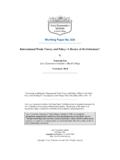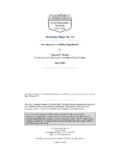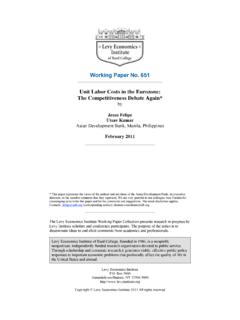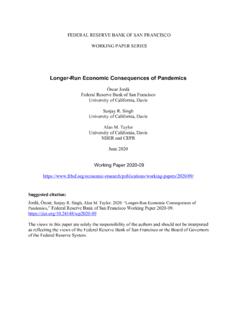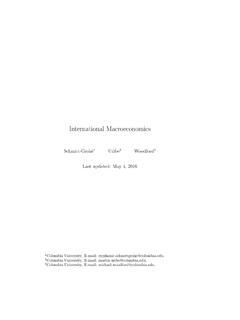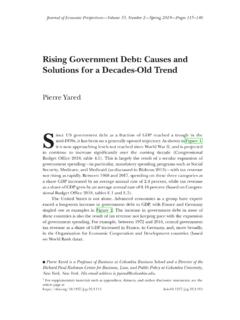Transcription of Working Paper No. 891 - Levy Economics Institute
1 Working Paper No. 891 Stock-flow Consistent Macroeconomic Models: A Survey by Michalis Nikiforos and Gennaro Zezza Levy Economics Institute of Bard College May 2017 The Levy Economics Institute Working Paper Collection presents research in progress by Levy Institute scholars and conference participants. The purpose of the series is to disseminate ideas to and elicit comments from academics and professionals. Levy Economics Institute of Bard College, founded in 1986, is a nonprofit, nonpartisan, independently funded research organization devoted to public service. Through scholarship and economic research it generates viable, effective public policy responses to important economic problems that profoundly affect the quality of life in the United States and abroad.
2 Levy Economics Institute Box 5000 Annandale-on-Hudson, NY 12504-5000 Copyright Levy Economics Institute 2017 All rights reserved ISSN 1547-366X 1 ABSTRACT The stock-flow consistent (SFC) modeling approach, grounded in the pioneering work of Wynne Godley and James Tobin in the 1970s, has been adopted by a growing number of researchers in macroeconomics , especially after the publication of Godley and Lavoie (2007), which provided a general framework for the analysis of whole economic systems, and the recognition that macroeconomic models integrating real markets with flow-of-funds analysis had been particularly successful in predicting the Great Recession of 2007 9. We introduce the general features of the SFC approach for a closed economy, showing how the core model has been extended to address issues such as financialization and income distribution.
3 We next discuss the implications of the approach for models of open economies and compare the methodologies adopted in developing SFC empirical models for whole countries. We review the contributions where the SFC approach is being adopted as the macroeconomic closure of microeconomic agent-based models, and how the SFC approach is at the core of new research in ecological macroeconomics . Finally, we discuss the appropriateness of the name stock-flow consistent for the class of models we survey. Keywords: Macroeconomic Models; Stock-flow Consistency; Financial Models; Economic Policy JEL Classifications: E1, E17, E50, E60, F41, G00 2 1. INTRODUCTION The stock-flow consistent (henceforth SFC) approach to macroeconomic modeling has become increasingly popular among economists of different persuasions.
4 Despite its roots going back at least five decades, its popularity increased exponentially after the recent crisis of 2007 9. Two factors played a significant role in that: first, the 2007 publication of Monetary Economics , by Wynne Godley and Marc Lavoie (2007a), a book that summarizes and synthesizes the basic principles and modeling methods; and second, the recognition that models and policy analyses based on the SFC framework ( , Godley 1999a) were able to predict the crisis, which caught the majority of the profession by surprise. For these two reasons the years of the Great Recession are a demarcation point in time that separates the early period of the development of the SFC approach from the more recent period. The main characteristic and advantage of the SFC approach is that it provides a framework for treating the real and the financial sides of the economy in an integrated way.
5 In a modern capitalist economy, the behavior of the real side of the economy cannot be understood without reference to the financial side (money, debt, and assets markets). Although this is a general statement, it became particularly evident during the recent crisis and the slow recovery that followed (hence the aforementioned surge in the popularity of SFC models). For that reason, the SFC approach is an essential tool if one wants to examine the political economy of modern capitalism in a rigorous and analytical way. The roots of the SFC approach go back to the late 1960s and 1970s, a hard time for Keynesian economists, who saw their influence decline in favor of monetarism and then later New Classical Economics (Dos Santos 2006). The two main figures in these nascent years were Wynne Godley at the University of Cambridge and James Tobin at Yale University.
6 Godley, after Working for 14 years at the Treasury, joined the University of Cambridge as the director of the Department of Applied Economics , within which he also formed the Cambridge Economic Policy Group. His writings at the time most done together with Francis Cripps contain the basic elements of the principles of SFC modeling that we will discuss below (Godley and Cripps 1974, 1983; Cripps and Godley 1976, 1978). Since these early days, the two basic characteristics of Godley s 3 approach are an effort to combine economic theory and policy (not surprising for someone who had spent 14 years at the Treasury) and successive attempts to build rigorous models that combine the real and the financial sides of the The work of Godley was highly influenced by Nicholas Kaldor.
7 The two met while Godley was at the Treasury and it was Kaldor who brought him to Cambridge. Among other things, it was discussions with Kaldor that led Godley to identify and recognize the importance of the three balances, which we will discuss in some detail in section 4. Kaldor had already mentioned these balances three decades earlier (Kaldor and Barna 1944), though without then recognizing their importance. At the same time, on the other side of the Atlantic, James Tobin developed a similar approach, which came to be known as the pitfalls approach. The approach was developed in a series of papers, many of which were coauthored with William Brainard (Brainard and Tobin 1968; Tobin 1969; Backus et al. 1980), and was summarized in Tobin s Nobel Prize lecture (Tobin 1982).
8 According to Tobin, the main pitfall in financial-model building is the failure to explicitly model that the prices and interest rates determined in these [financial] markets and the quantities to which they refer both influence and are influenced by the real economy [..]. These interdependencies are easy to acknowledge in principle but difficult to honor in practice, either in theoretical analysis or in empirical investigation (Brainard and Tobin 1968: 99; emphasis added). The aim of Tobin s research project was thus to provide an analysis that properly takes care of these interdependencies. As we will discuss in more detail in section , among other things, Tobin set out the principles that determine portfolio choice within these models. The latest part of this long first phase of the formation of the SFC approach started in 1994 when Godley arrived at the Levy Economics Institute of Bard College and ends with the publication of Monetary Economics (the book was the result of a long research project, undertaken together with Marc Lavoie from the University of Ottawa).
9 At the same time, and in accordance with his preference for a combination of theory and policy, Godley created the Levy Macroeconomic 1 Cripps and Lavoie (2017) provide a biographical discussion of Godley s works and methods. 4 Model, a policy model based on SFC principles, which proved successful in predicting the downturn of 2001 and the Great Recession. As we mentioned above, since the publication of Monetary Economics there have been extensive contributions to the literature adopting the SFC method for examining a variety of issues. The purpose of this Paper is to provide a detailed survey of this literature, as well to show how this approach provides innovative contributions to policy debates related to austerity policies, balance of payment imbalances, long-term sustainable growth, etc.
10 Towards that goal, in the next section we provide an overview of the basic principles of SFC modeling, which will also act as an entry and a reference point for the discussion that will follow. These principles can be divided into two broad categories. First, the building of the models starts with a lot of attention to accounting consistency. In the words of Taylor (2004: 206), making sure that the accounting is right is often the best way to attack a problem in Economics . Careful accounting can lead to interesting conclusions in its own right because it imposes certain constraints and reduces the degrees of freedom of the model. The second category consists of the closure and the behavioral specifications of the model. SFC models have a post-Keynesian closure, in the sense that demand matters and full employment is not considered to be the general state of the economy.
